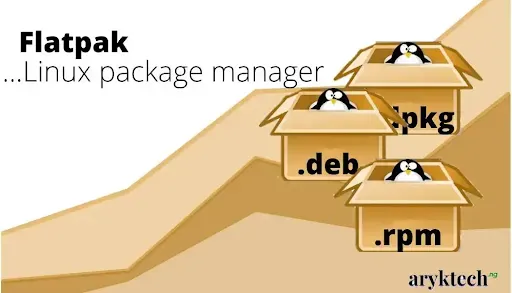
Flatpak can be referred to as a quick and easy to install package manager for Linux distributions which uses Flathub as a platform for distributing these applications.
In one of my previous posts, I have discussed Flathub to a reasonable length. In this post, however, I would be talking more about Flatpak than Flathub.
Meanwhile, if you have seen my previous post whereI discussed Flathub at length, you may have already understand the relationship between Flatpak and Flathub. In any case, this post is compiled to educate you more about Flatpak.
In this post, I would be talking about things like Flatpak functions, the reason for using Flatpak, what issues are solved or resolved by Flatpak and the likes of it.
So, to start with, let me introduce you to Flatpak.
What is Flatpak?
As was hinted earlier, Flatpak can be referred to as a quick and easy to install package manager for Linux distributions which uses Flathub as a platform for distributing these applications.
As a package manager, Flatpak combines, compiles, and delivers applications in a single package. Because Flatpak supports longer and frequent updates, you can get both rock-solid stable and the latest packages on its distribution platform known as Flathub. Thus; Flatpak uses Flathub as the package repository.
Meanwhile, it should be noted that you cannot find Linux applications for development and back-end system tools on the Flatpak package manager. This is because Flatpak only produces applications for the Linux desktop environment.
And now, why would you need Flatpak when you can actually install your favourite applications directly on your Linux PC?
What's the Need for Flatpak?
Since Linux offers free and open-source desktop distributions, there is plenty of open-source software available for Linux systems. However, in order to install a software on your Linux PC, you need to know the right or should I say; the best method for installing the software so that both the process for installing and managing the software can be smooth and easy for you.
Meanwhile, software installation on a Linux system could be tricky if you don’t know how to find the perfect method for installing the specific software. And this is where tools like Flatpak come in.
If you are already familiar with software installation on Linux desktop environment, most likely; you are aware that different Linux flavours package their software differently. For example, when we talk about the Debian and the Red Hat-based Linux distributions, we know that they all have their own package management system. Ubuntu and other Debian distributions use the .deb package extension to build packages while Red Hat, Fedora, CentOS, and other Red Hat-based Linux use the .rpm package extension to build packages.
However, there are also a few command-line based methods for installing packages on the Linux system but there occur issues with this method almost always. The problem occurs when the command-line contains a broken URL or a server address, or a repository link.
In other times, the unstable repository link might be the sole reason for the failure experienced when installing a package on your Linux PC using this method.
Another possible problem with the command-line based method is that; sometimes, the native package manager might fail to download packages from the repository server due to geo-location restrictions whereas, in cases as this; a third-party universal package manager might be able solve the problems.
So, in order to eliminate these issues and make the process of installing packages on Linux desktop environment straightforward, software developers have decided to build tools like Flatpak package manager.
Thus, regardless of your Linux distributions or the package extension acceptable by your Linux distro, you can always install software programs on your Linux PC using Flatpak package manager.
In other words, you can also say that using Flatpak package manager is easy to use and available for all the major Linux distributions.
So, how is Flatpak able to distribute, install and manage applications across Linux desktop environments regardless of the Linux distro? Well, the answer to this question brings us to explaining briefly, how Flatpak functions.
How Does Flatpak Work?
Flatpak uses sandbox technology to store and install packages on a Linux system and sometimes, Flatpak cannot access and utilize the system’s total resource which is why you sometimes could notice or experience dependency issues on the Flatpak package manager.
So, what Flatpak does is that; Flatpak pre-compiled the packages and delivers a complied version of the package which is why no source code is found on the package repository.
Not withstanding, Flatpak is well over ninety percent more reliable a method for installing and managing applications on your Linux PCs.
In conclusion
Through Flatpak's Flathub which is a growing platform, you can easily find hundreds of Linux applications to install on your Linux PC.
All you may ever need to do on your Linux PC is to follow the simple Flatpak setup instructions and install the Flatpak package manager on your Linux PC and from there; you can easily install, uninstall, re-install, update and perform all other applications management tasks on your Linux PC.



0 Comments